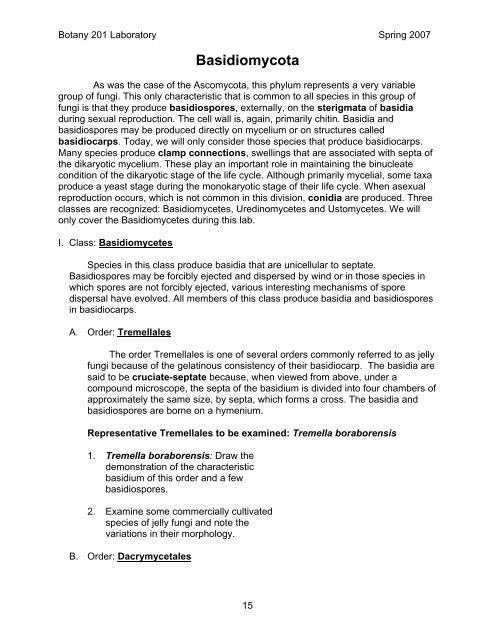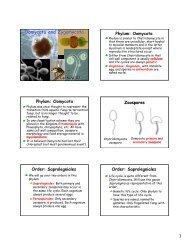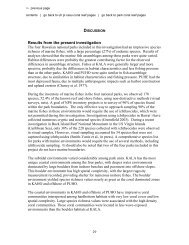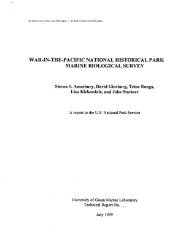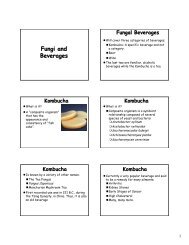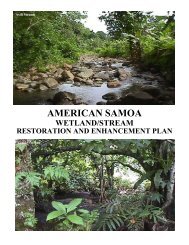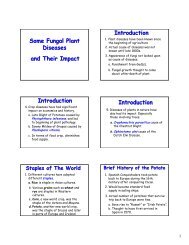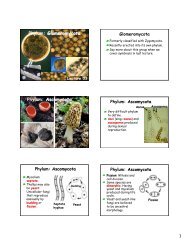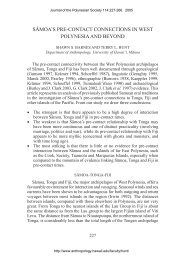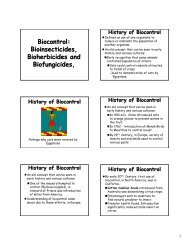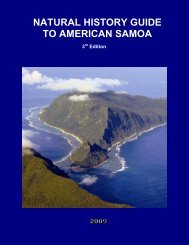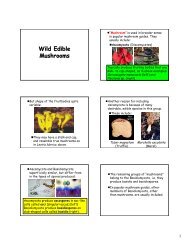Basidiomycota
Basidiomycota
Basidiomycota
You also want an ePaper? Increase the reach of your titles
YUMPU automatically turns print PDFs into web optimized ePapers that Google loves.
This order has fungi whose basidiocarps are generally leathery to woodyrather than fleshy due to the presence of dimitic or trimitic hyphae. These fungiare commonly referred to as "conks" or "polypores". The basidiocarps arevariable in shape as is the hymenium, which may be smooth, have lamella,pores, teeths, etc. These species are often found as decomposers on woodysubstrates.Representative Basidiomycetes to be examined: Ganoderma australis,Sarcodon atroviridis and Schizophyllum commune1. Ganoderma australis: Basidia andbasidiospores of this species are borne ina hymenium that consists of pores.Because the pores are very small, you willneed a hand lens or a dissectingmicroscope to see the pores of thisspecies. Also, note the very woodyconsistency of this basidiocarp. Do youthink that this is entirely fungal? Draw thebasidiocarp and indicate where the poresare produced.2. Sarcodon atroviridis: Basidia andbasidiospores are borne on the surface ofa hymenium that consists of spines on thebasidiocarp. Draw the basidiocarp andindicate where the spines are produced.3. Schizophyllum commune: Basidia andbasidiospores are borne on the surface ofa hymenium that consists of gills. Howdoes this differ from the Agaricales?E. Various cultivated “mushrooms”Many species of mushrooms are cultivated for food. Look at some of thedemonstrations of cultivated species: Agaricus bisporus has several variety thathave been cultivated, two here are the “A. bisporus proper” and the Portabello,Pleurotus ostreatus (Oyster mushroom) and Lentinellus edodes (Shitake).Other species cultivated include Tremella fuciformis (Silver ear),Auricularia polytricha (Ear fungus or Pepeiao) and Ganoderma lucidum (Reishi).Gasteromycetes (=Puffballs)The taxon, Gasteromycetes, no longer has any official status. It represents anarray of fleshy fungi that are of different phylogenetic lines. However, they do share animportant characteristic. Because puffballs do not forcibly eject their basidiospores, they17
have evolved various mechanisms by which they disperse their spores. They also differfrom other Basidiomycetes in that their basidia and basidiospores are not produced in ahymenium. Another term, the gleba, is used to refer to the part of the basidiocarp wherethe basidia and basidiospores are borne. Some of the orders, below, will be examinedto illustrate some of the interesting mechanisms that have evolved for spore dispersal.E. Order: LycoperdalesThis order produces basidiocarps that are globose, to pyriform, with anostiole where the basidiospores are released. The basidiocarp is a flexible "sac"or peridium that encloses the basidiospores or gleba. At maturity, the spores aredry and powdery. When an object, such as a raindrop or small mammaldepresses the peridium, the force pushes the basidiospores out the ostiole, inwhat appears to be a cloud of smoke, and disperses them into the air where theyare carried by the wind.Representative Lycoperdales to be examined: Lycoperdon sp.,1. Lycoperdon sp: Examine the basidiocarpdisplayed. Draw and identify the peridiumand ostiole of the basidiocarp. Gently,push your pencil against the peridium andobserve the powdery basidiospores asthey are puffed out the ostiole.F. Order: PhallalesThis order is commonly called the stinkhorns because of the offensiveodor that they emit. They come in various size and shapes with glebas that areusually very slimy in appearance and dull grayish-brown in color. The part of thebasidiocarp underneath the gleba is usually a bright color that is masking a brightshade of yellow, orange, red or green, underneath. The combination of the glebacolor, offensive odor and bright color attracts flies that disperse thebasidiospores.Representative Phallales to be examined: Aseroe rubra1. Aseroe rubra: When fresh, this speciesof stinkhorn has a slimy, grayish-browngleba and is bright red in the surroundingarea. Although the preserved specimen isvery poor, attempt to draw the basidiocarpof this species and identify the gleba.How are the basidiospores dispersed inthis and other stinkhorns? Where is theperidium in this fungus?G. Order: Nidulariales18
This group is commonly referred to as the bird's nest fungi because theirappearance superficially resembles a bird's nest with eggs. The "eggs" are theperidioles, which contain the basidia and basidiospores. In this mechanism, it isthe peridioles that are dispersed. Although the mechanism of dispersal is aninteresting one, it is not one that carries the fungus any great distances.However, it does spread it, continuously, over a large area, at small, distanceintervals with each dispersed peridiole. The peridioles are splashed out of theperidium (=nest) by raindrops up to a distance of approximately 24". As theperidoles are ejected out of the peridium, the sudden ejection causes a rope-likestructure, the funiculus that is neatly coiled in the peridiole to unwind. A stickyarea, the hapteron, at the end of the funiculus can attach itself to a nearbysubstrate. If this occurs, the sudden stop causes the funiculus to wrap aroundand attach itself to the substrate.Representative Nidulariales to be examined: Cyathus sp.1. Cyathus sp.: The basidiocarp of the bird’snest fungi is the most complex among theGasteromycetes. Draw and identify theperidium and peridiole. Dissect aperidiole under the dissecting microscopeand identify the funiculus and hapteron.A demonstration showing how dispersal isaccomplished will be carried out during thislab.19


